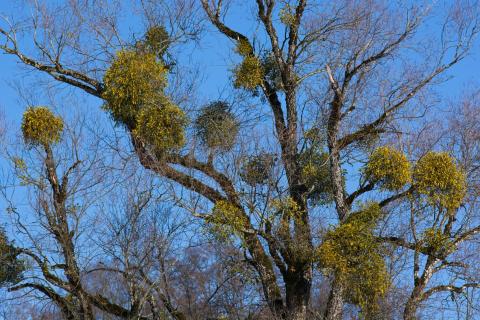The Most Popular Holiday Parasite

Mistletoe has fascinated people for thousands of years, inspiring many myths and traditions. Nowadays, it is a romantic Christmas tradition to stop and kiss under a sprig of mistletoe. What many may not know is that this plant is actually a vicious parasite. Before you hang up the mistletoe this holiday season, take a moment to learn more about this iconic plant and its historical uses.
What is Mistletoe?
Botanically, mistletoe is a semi-parasitic flowering plant found in the woodlands of temperate regions throughout the world. Mistletoe parasitizes trees and shrubs, drawing water and mineral nutrients from the host plant using highly modified root structures called haustorium. Unlike other parasitic plants such as dodder (Cuscuta spp.), mistletoe creates its own energy though photosynthesis.
Mistletoe is often considered a pest species, particularly in agricultural settings, as it weakens host trees, stunting or killing them. Despite this, mistletoe is very important ecologically. Its fruit is a key food source for frugivorous songbirds, and some birds use it directly as a nesting site. Birds are also responsible for mistletoe dispersal. The pulp of mistletoe fruit is very sticky and the seeds will cling to a bird’s beak until they are wiped off onto tree branches. The seeds can also pass unharmed through a bird’s digestive tract and be spread in that manner.
Two species of mistletoe are commonly associated with Christmas, European mistletoe (Viscum album) and its North American relative, American mistletoe (Phoradendron leucoparum). Although not native to New Hampshire, American mistletoe can be found growing in the branches of deciduous trees from New Jersey to Florida and west to Texas and Illinois. In New England, it is possible to find Dwarf mistletoe (Areceuthobium pusillum), which causes unusual growths called witches brooms on spruces, pines and tamaracks.
The History of a Christmas Tradition
Long viewed as a symbol of fertility and love, mistletoe’s evergreen nature makes it a beacon of vitality in the winter months. When all the leaves have dropped from the trees, mistletoe stands in sharp contrast. The ancient Romans and Greeks used it medicinally to cure everything from epilepsy to ulcers. In Norse mythology, mistletoe represented love and peace.
The Celtic Druids correlated mistletoe with love and fertility based on the sexual connotation of the fruit’s sticky white pulp. These associations continued through the Middle Ages, and by the 18th century it was included in Christmas celebrations, at which time men were allowed to “steal” a kiss from any woman standing under the mistletoe. In America in the mid-1800s, a berry was plucked off the mistletoe with each kiss. After all the berries were gone, the mistletoe lost its smooching power.
Today, you can find mistletoe in floral shops around the holidays. Both European and American mistletoe are wildly harvested and sold at Christmas. Remember that mistletoe is incredibly toxic to humans and pets and should always be displayed well out of the reach of children.
Do you love learning about stuff like this?
SUBSCRIBE TO GRANITE STATE GARDENING
A monthly newsletter for New Hampshire gardeners, homesteaders and plant-lovers of all kinds, that includes seasonal suggested gardening tips, upcoming events and articles with proven solutions for your garden and landscape.
Got questions? The Ask UNH Extension Infoline offers practical help finding answers for your home, yard, and garden questions. Call toll free at 1-877-398-4769, Monday to Friday, 9 a.m. to 2 p.m., or e-mail us at answers@unh.edu.
